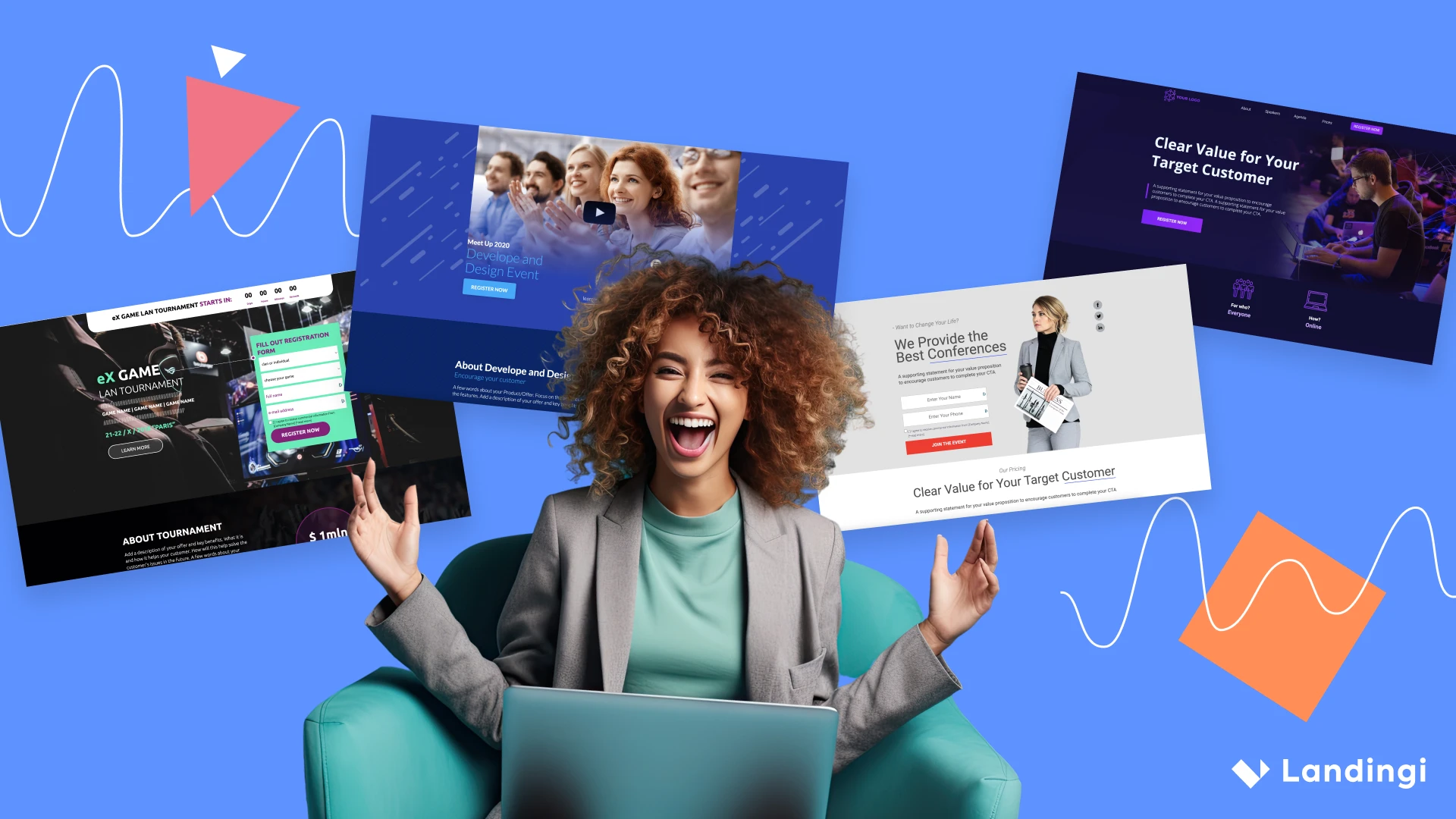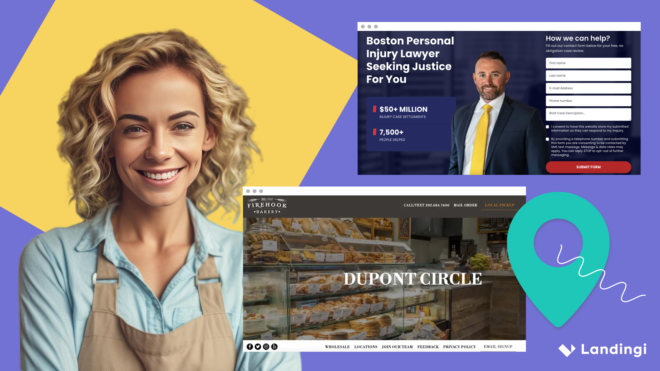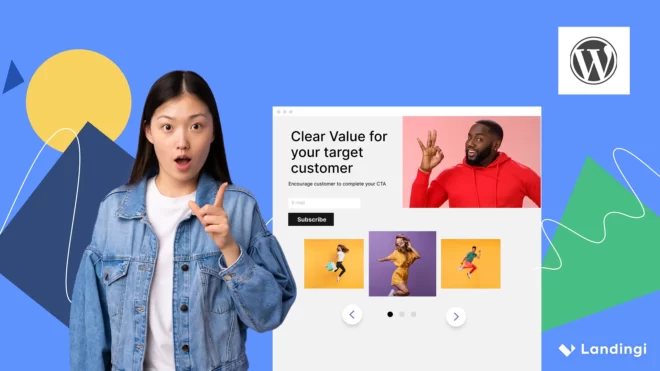Seeking inspiration for your event’s landing page? This concise guide showcases a range of striking event landing page examples. From conferences to festivals, these pages excel in converting visitors to attendees.
Event landing pages can be useful when you want to promote:
- business meetings and conferences,
- expos,
- training and courses,
- concerts and festivals,
- exhibitions and art events,
- trips,
- and any other event, from official ones to celebrations.
Check out landing page examples, and uncover the essential components that make them effective. Cases from the article will show you the know-how to craft your successful event landing page.
Make your sections smartable and let go of mundane manual tasks with Smart Sections! An easy way to manage bulk changes.
What Should Event Landing Page Include?
Event landing page should include all necessary details about the event, such as the event name, date, location, and the essential elements of a converting landing page, encompassing the following:
- clear schedule,
- detailed speaker information,
- compelling event description.
These components inform and entice potential attendees effectively. But remember, a great event landing page is not just about cramming in all the details; it’s about presenting them in a visually appealing and easy-to-navigate layout.
The design and visuals of your event landing page play a crucial role in enhancing user experience.
Here’s how to make the most of it:
- Use high-quality, relevant visuals.
- Keep the design clean and simple.
- Stick to a limited color scheme that matches your brand identity.
- Incorporate elements to create a fear of missing out (FOMO).
- Use testimonials for social proof.
- Include engaging content such as interviews or video highlights from past events.
Still, the goal is not just to attract potential attendees but to convert them into actual attendees. Without contact options and compelling CTAs, an event landing page is incomplete. Offering direct support through contact options like a phone number can reassure visitors. A powerful call-to-action is a must, as it aids in event registration, simplifies the process, and enhances the landing page experience.
7 Examples of Event Landing Pages
Explore some real-world event landing page examples that have successfully implemented strategies. These examples cover a variety of event types, from conferences and training sessions to art exhibitions or concerts. Each one showcases a unique approach to design and content, providing valuable insights and inspiration for creating your own event landing pages.
1. Conference Example
In the realm of conference landing pages, details reign supreme. The agenda, for instance, is prominently featured in the page header section, offering visitors immediate access to the event date and venue information. This way, potential attendees can quickly determine if the conference fits into their schedule and plan accordingly.
Another key component is the speaker line-up. It’s a good practice to use a visually compelling design that captivates visitors’ attention and offers comprehensive details about their expertise. This effectively showcases the value of attending the conference, enticing potential attendees to register.
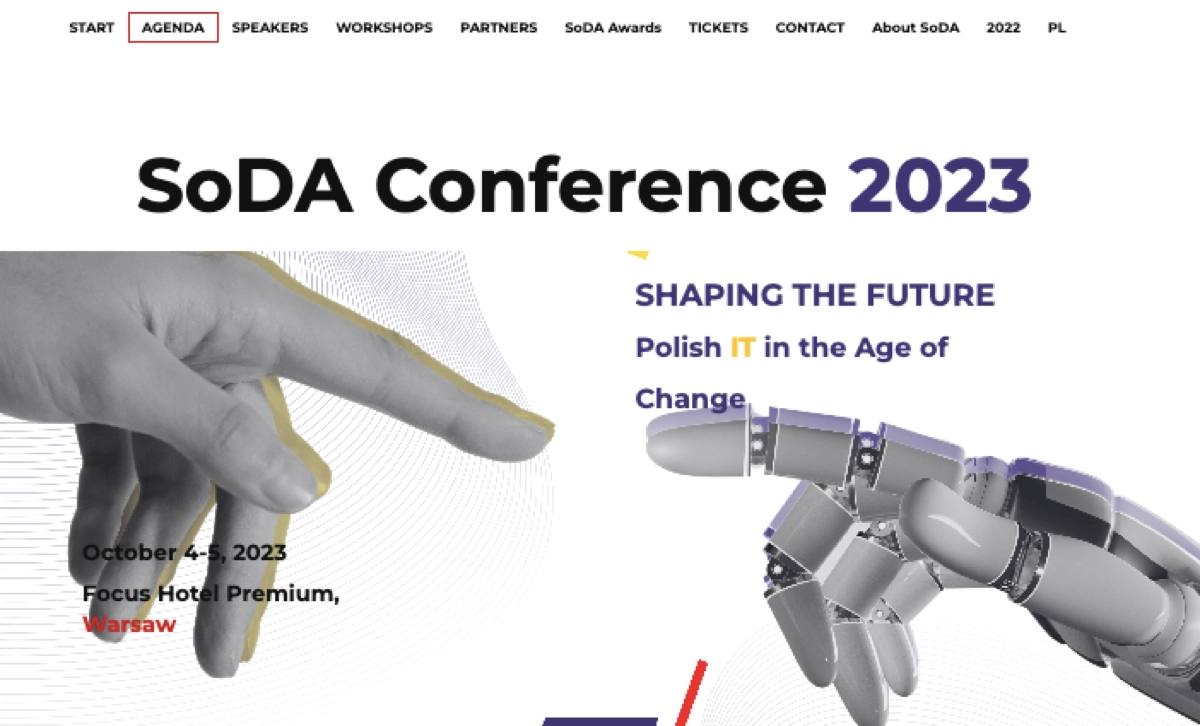
Finally, conference landing pages are tailored to specific audiences and provide networking opportunities. The SoDA Conference event landing page does this exceptionally well.
They showcase the value of attending by providing information about past events, including testimonials, video highlights, and speaker line-ups. This not only builds credibility but also generates interest among potential attendees.
Key Takeaways:
From the example above, you can notice that the successful event landing page for conferences should include a couple of specific components that affect its effectiveness, including the following:
- agenda,
- speakers list,
- value of attending.
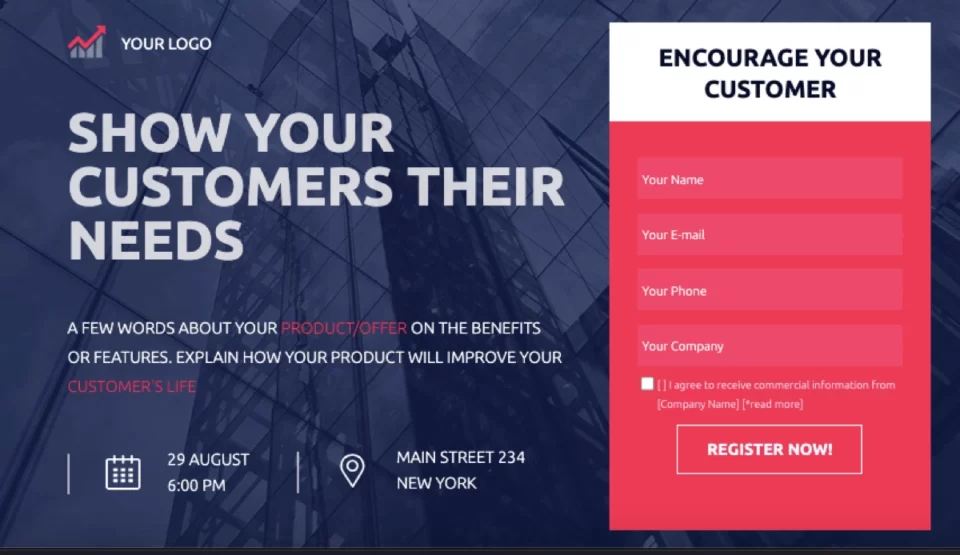
Take a look at the Business Conference template of the Landingi library
The template contains each important conference landing page detail, such as:
- section with the place and date of an event,
- agenda section,
- speakers section,
- simple opt-in form,
- strong CTA buttons,
- visual sections,
- pricing section,
- contact section.
By using this template within the landing page builder, you can effortlessly adapt it for your purposes, customizing every part of the template and adding widgets, such as a countdown, to create your own high-converting conference landing page.
2. Training Example
Training event landing pages present unique requirements and challenges. You can find its critical elements below to consider:
- Clearly outline the learning objectives. Articulate the specific outcomes that participants can anticipate achieving through the course.
- Address the challenges faced by the target audience. Show how the training will help them overcome these challenges.
- Include a clear and concise registration form. Streamline the sign-up process and encourage potential attendees to register.
By incorporating these elements, you can create an effective training event landing page.
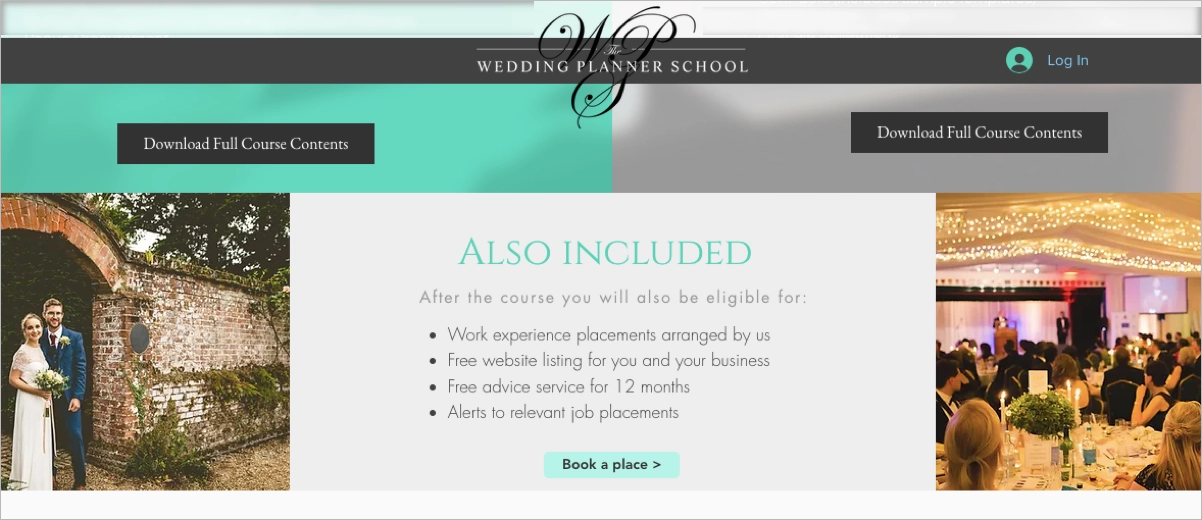
The example of Wedding Planner School shows how to include all necessary information and engage visitors with a perfect layout at the same time.
In the case of training & course landing pages, course content information is a crucial component. An engaging headline, high-quality visuals, and a compelling presentation of the course’s value can encourage prospective students to proceed further. This not only captures the attention of potential attendees but also motivates them to register.
Remember that the credibility of the instructor is paramount. The credentials of the instructor must be displayed clearly.
Key Takeaways:
Taking a look at the example above, you can observe what’s essential to create a robust training landing page. Some specific components that make it convert are the following:
- information content,
- section about the instructor,
- clear, alternative CTAs.
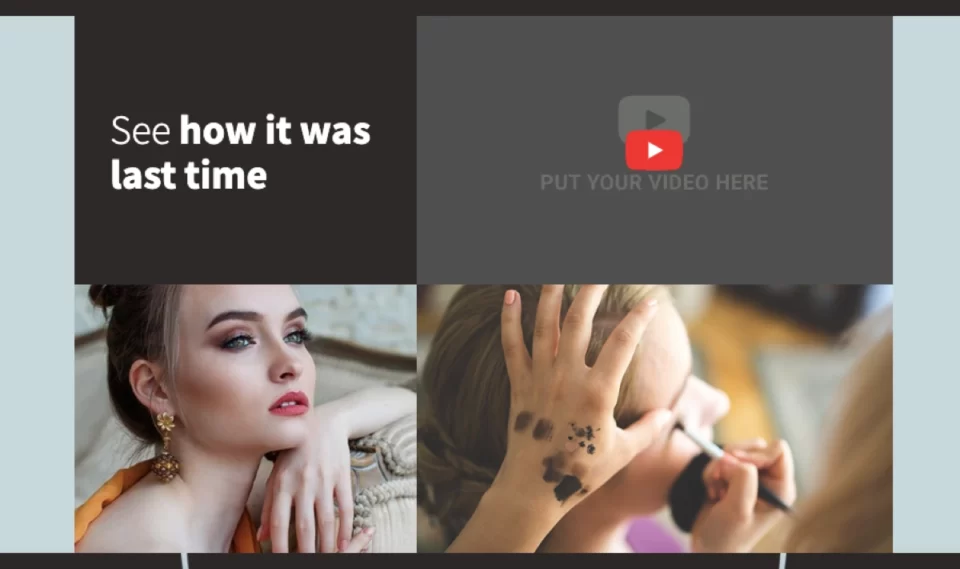
To create a similar landing page, you can use the Register For a Course template from Landingi and customize it to promote your course
The pattern above contains components important to create a powerful course landing page, including the following:
- strong CTA buttons,
- timetable section,
- benefits section,
- reviews section,
- layout prepared for high-quality visuals,
- single opt-in form,
- contact section.
By choosing Landingi to craft your course landing page, you can extend the template by adding widgets or buttons. Using built-in AI tools will help you to create effective content that leads visitors to convert.
3. Expo Example
To generate interest and increase attendance, expo event landing pages necessitate a different strategy, such as capturing contact information or encouraging visitors to stay on the event website to purchase tickets or register their interest.
Exhibitors are a key part of fairs, and their effective showcase is crucial. This can be done by implementing a list of participating companies, their names, and their sponsorship or exhibitor levels. Good practices also include showcasing past events and the success of previous exhibitors, which can help to build credibility and generate interest among both potential event participants and potential exhibitors.
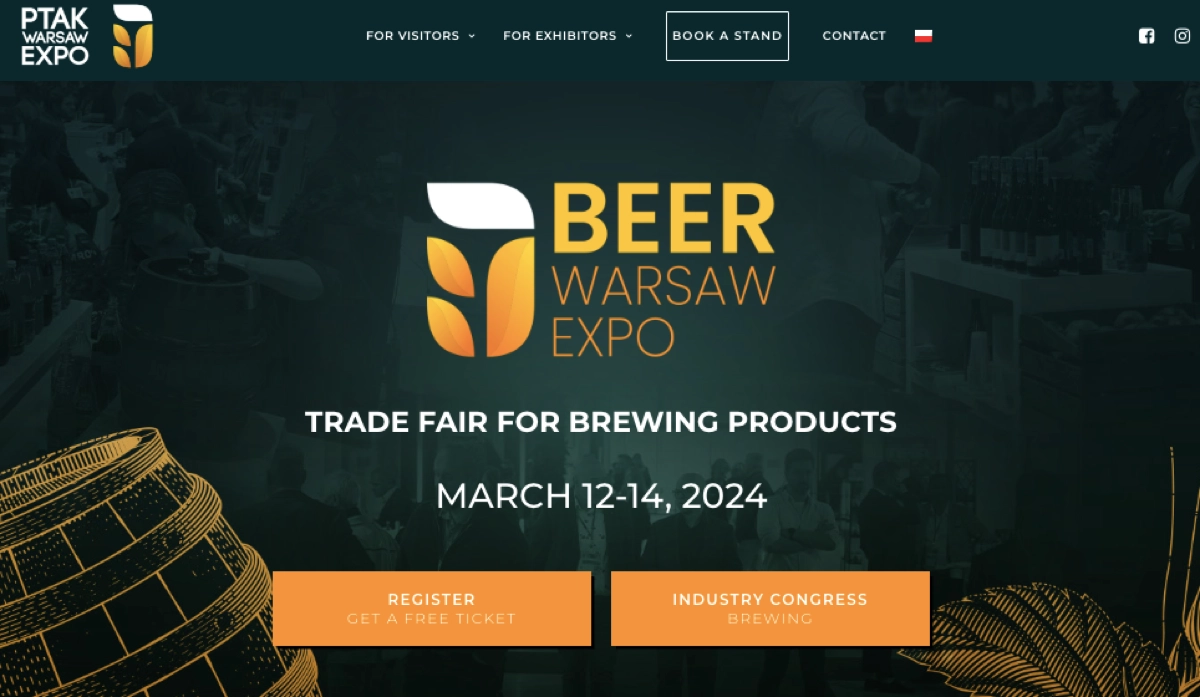
Lastly, integrating interactive elements into a fair event landing page is crucial. These elements elevate the user experience and align with the event theme. As in the Beer Warsaw Expo, high-quality visuals and videos elevate users’ interest. Strong, alternative CTAs here allow visitors to choose an action that refers to their role.
Key Takeaways:
The example of the expo event landing page above shows specific elements that affect its higher conversion, such as:
- main theme in the background,
- section with the list of exhibitors,
- contact and location sections,
- distinctive CTAs.
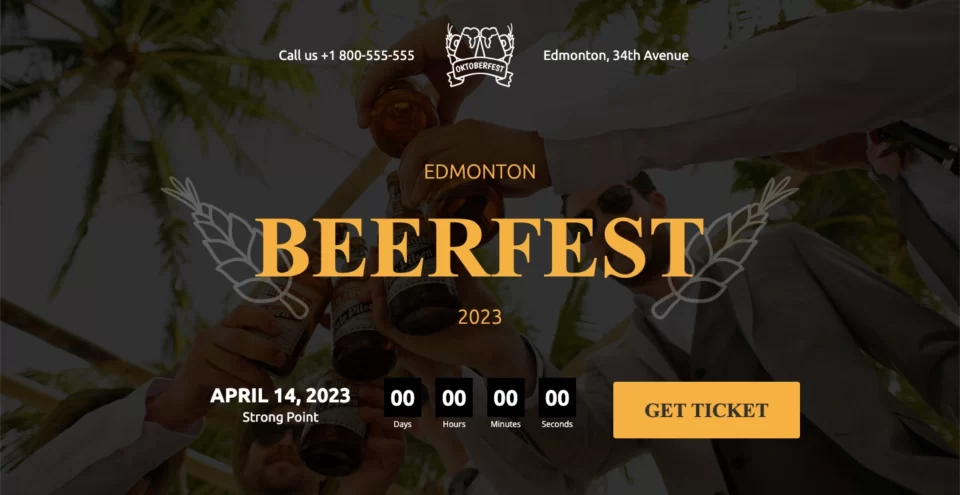
Take a look at the Festival template from the Landingi library below
This sample refers to the same expo type as our external choice, but it can be suitable for every other type of fair. Specific elements the template contains are the following:
- countdown widget,
- contact and location sections,
- section for catchy content,
- outstanding, effective CTAs,
- visual sections.
If you decide to use Landingi in your expo event landing page creation process, be sure it will go effortlessly. An intuitive toolkit with AI solutions helps to change ideas into reality.
4. Concert Example
When it comes to concert event landing pages, the key is to create a sense of excitement and anticipation. The page should be vibrant, energetic, and reflective of the atmosphere of the concert. Essential elements of an event landing page for a concert you should use in your project are the following:
- A clear, bold headline announcing the concert name and the performing artists or bands,
- High-quality, engaging visuals such as artist photos, past concert images, or promotional videos.
- Detailed information about the concert, including date, time, venue, and ticket prices.
- A clear and compelling single CTA, like “Reserve Your Spot.”
A concert landing page should be clear for visitors, as in the example of Oslo Konserthus, which promotes all concerts in a similar way. The CTA is clear and compelling, encouraging visitors to buy tickets. The page also includes adequate content to encourage potential attendees to purchase tickets.
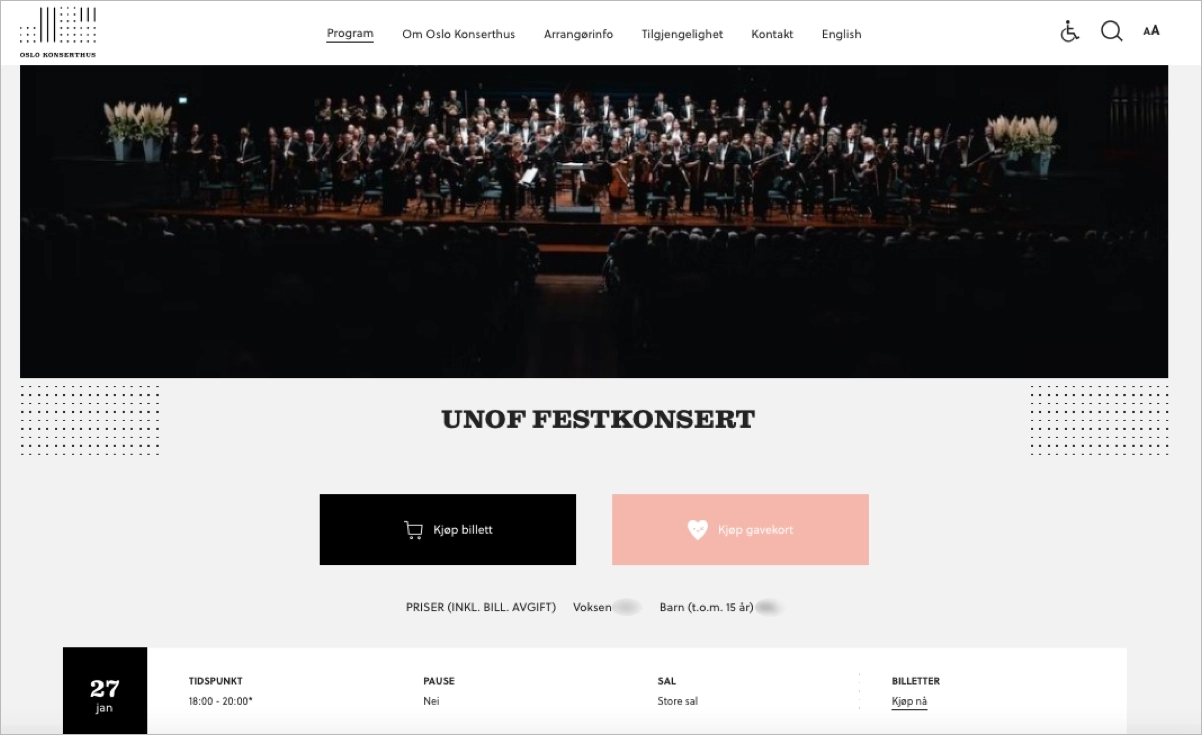
Last but not least are elements that increase user experience, such as the contact section, location map buttons, or concert hall map, which simplify the supposed actions most of the event attendees will take.
Key Takeaways:
Characteristics that you can notice in the example above should be a pattern for your own concert landing page. Those are the following:
- clear headline with artists’ names,
- outstanding CTAs,
- high-quality visuals,
- concert hall map section.
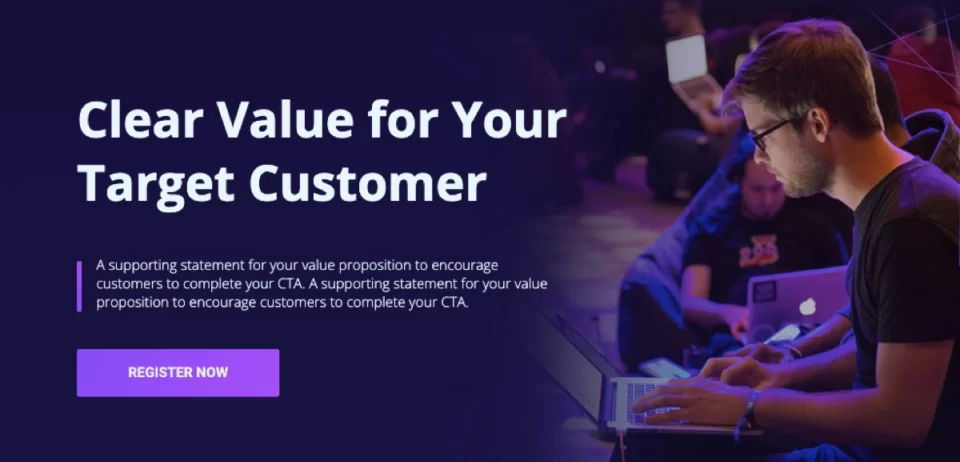
Check out one of the Landingi templates
Specific elements of this pattern are adequate for a concert landing page:
- clear timetable section,
- strong CTAs,
- visual sections,
- agenda section.
By adding several widgets available in the intuitive toolbar of the Landingi editor and customizing visuals and colors, you can change this template into an effective concert landing page in minutes.
5. Art Exhibition Example
Art exhibition landing pages need to capture the essence of the artwork and the atmosphere of the event. The page should be visually appealing, mirroring the aesthetics of the exhibition itself and, at the same time, showing the style of a gallery or museum. The key components of an effective art exhibition landing page include a headline announcing the exhibition name and the featured artists or artworks, high-quality, engaging visuals, and detailed information about the exhibition.
The example of The Fotografiska landing page for their exhibition Shirin Neshat – The Fury provides a great template. The CTA is clear and compelling, encouraging visitors to buy tickets. The page also includes adequate content to encourage potential attendees to visit.
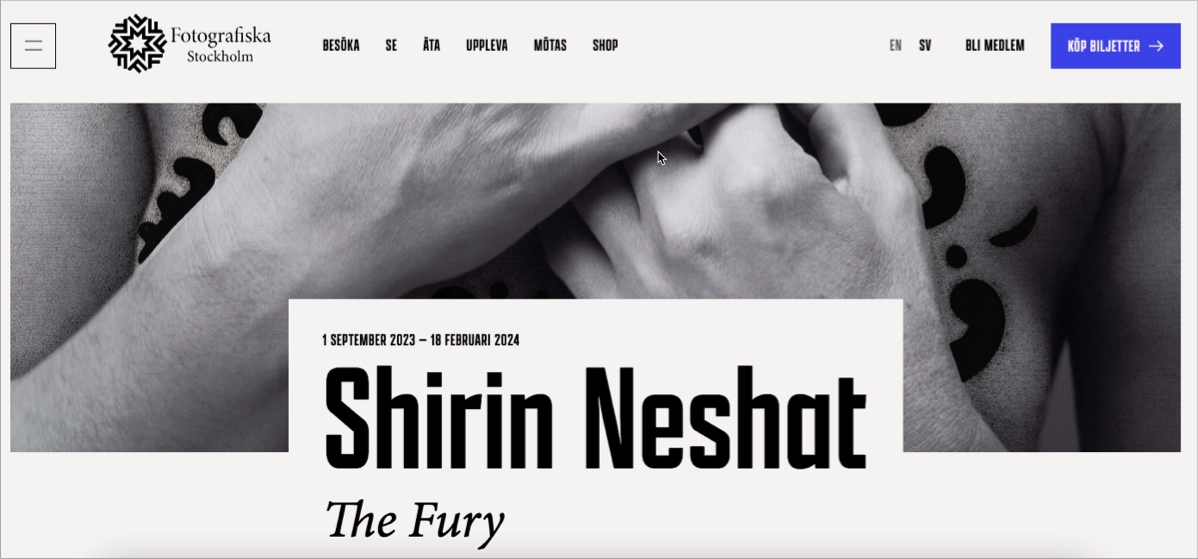
The page is simple and minimalistic, allowing the art to take center stage. It also includes additional information about the exhibition.
Key Takeaways:
Looking at the example above, the essential components to create a high-converting art exhibition landing page are the following:
- clear headline with exhibition and artist names,
- outstanding CTAs,
- high-quality visuals,
- additional information about the exhibition.

To create a similar landing page, you can use the Event template from Landingi and customize it to promote art events
Even though the template isn’t created for art exhibition events, its layout will let you adapt it to fit the purpose. The excellent base is its structure, which consists of:
- clear, minimalist design,
- content sections,
- visual sections,
- event details sections,
- section for artists’ info.
Unleash your creativity, add adequate visuals, compelling content, and clear CTAs within the Landingi editor, and enjoy creating a perfect art exhibition landing page.
6. Festival Example
When creating a festival event landing page, the goal is to capture the energy, excitement, and unique vibe of the event. This can be accomplished by incorporating vivid, high-quality visuals, engaging narratives, and a clear, persuasive CTA.
The landing page should prominently highlight key details such as the following:
- festival’s name,
- date and location,
- lineup,
- schedule,
- ticket pricing,
- unique attractions or features.
To enhance user experience, include a section dedicated to Frequently Asked Questions (FAQs). This can address common inquiries about parking, accommodation, amenities, and more, thereby reducing the need for potential attendees to reach out to festival organizers directly.
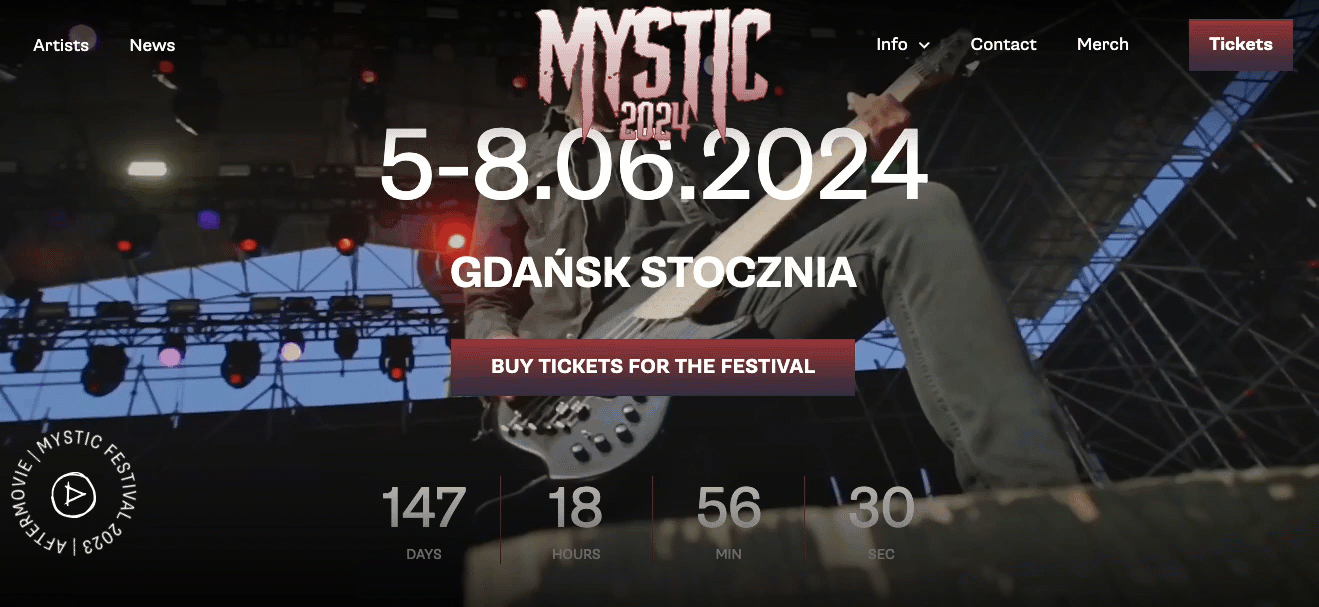
Finally, the design of the page should mirror the festival’s brand and aesthetic, creating a cohesive and captivating user experience, as in the example of Mystic Festival above. It’s a good practice to add elements like a festival map, artist bios, and links to social media channels. Lastly, ensure the festival landing page is mobile-responsive.
Key Takeaways:
The example of Mystic Festival shows the structure of components that build the effective festival event landing page. Your page should consist of the following:
- engaging visuals,
- outstanding CTAs,
- festival schedule and basic information about date and location,
- FAQs section.

If you are about to craft an eye-catching, engaging festival event landing page, try out the Landingi template
This sample refers to the festival event landing page type. Specific elements the template contains are the following:
- main theme background,
- contact and location sections,
- schedule sections,
- artists section,
- countdown widget.
When you’re using Landingi to craft your festival event landing page, you’re in for a smooth ride because every single element of our templates is customizable. You can add extra widgets or sections and boost conversions by implementing A/B tests. It’s like having a magic wand that transforms your ideas into a high-converting landing page. So, get ready to create a festival landing page that’s not just good but absolutely unforgettable!
7. Trip Example
Creating a landing page for a trip or travel event requires a strategic approach to entice potential attendees. The goal is to capture the excitement, adventure, and unique experiences that the trip offers. This can be achieved by incorporating high-quality visuals, engaging narratives, and a clear, persuasive CTA.
The landing page should prominently highlight key details such as the following:
- trip’s name,
- date and location,
- itinerary,
- ticket pricing,
- unique attractions.
To enhance user experience, it’s a good practice to include a section dedicated to Frequently Asked Questions (FAQs). This can address common inquiries about accommodation, amenities, and more, thereby reducing the need for potential attendees to reach out to trip organizers directly.
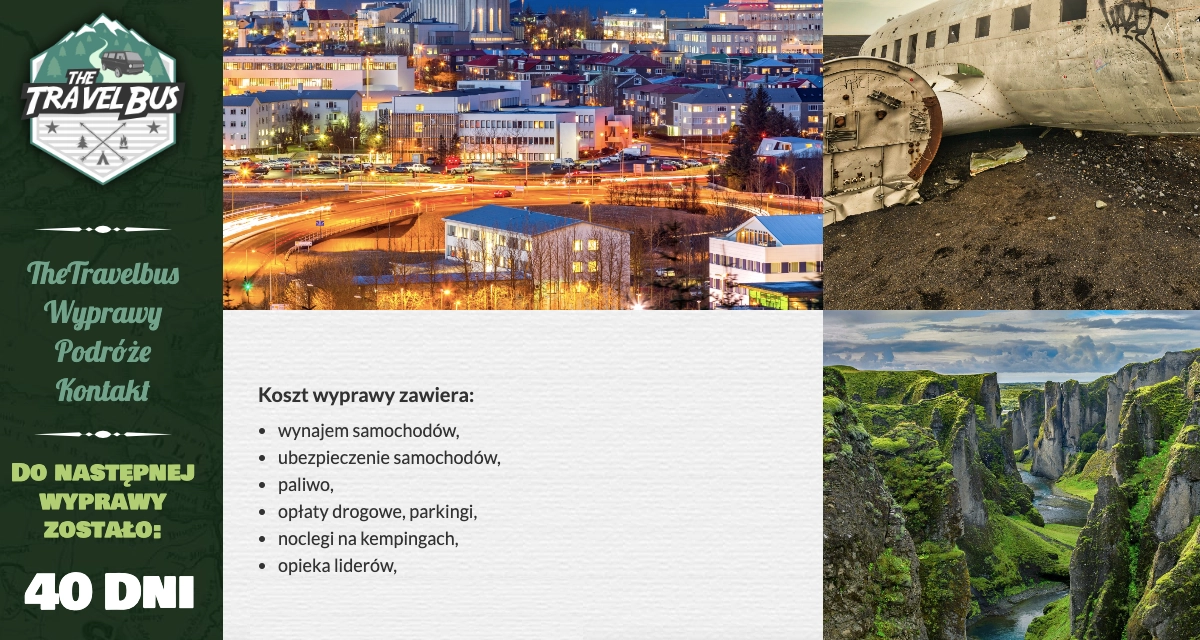
The design should create a cohesive and captivating user experience, as in the example of The Travelbus above. High-quality visuals are crucial elements of each travel landing page cause nothing engages travelers more than the views they can experience during a trip. As you may notice, it’s a good practice to add elements like a trip map, trip highlights, and links to social media channels. Lastly, adding a countdown widget makes visitors even more passionate about your offer.
Key Takeaways:
The example of The Travelbus “Around Iceland” trip landing page shows the structure of components that increase effectiveness. Your page should consist of the following:
- engaging visuals,
- outstanding CTAs,
- trip schedule and basic information about date and location,
- FAQs section.
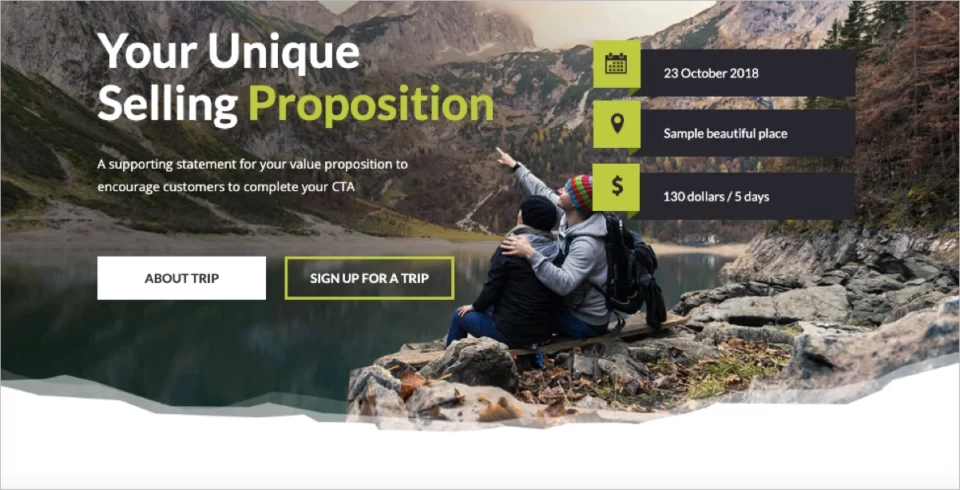
If you want to create an engaging trip event landing page, try out the Landingi Travely template
This template shows the specific elements of the trip event landing page, including the following:
- main trip information sections,
- trip plan section,
- single opt-in form,
- encouraging CTAs,
- trust elements sections.
With Landingi landing page builder, you can customize every part of a template or create your own trip event landing page, starting from the basic white page. With an intuitive toolkit and AI support, it’s a piece of cake for everyone, regardless of technical experience.
FAQ About Event Landing Pages
Given the numerous factors involved in creating an event landing page, having questions is quite understandable. In the following sections, we’ll address some of the most frequently asked questions about event landing pages. We’ll cover everything from the key elements of a landing page, through common mistakes to avoid, to the primary purpose of a call-to-action.
What Are the Key Elements of an Event Landing Page?
An event landing page for an upcoming event should include key elements such as the following:
- The event name
- Date and location
- Schedule and activities
- Speakers
- Registration or ticketing form
- FAQs
- Social proof
- Contact information
Of course, a compelling CTA button is a must. Incorporating these elements into your event landing page contributes to a perfect event page design that effectively captures the attention of potential attendees and encourages them to register.
The layout of your event landing page is crucial for engagement and conversions, necessitating a mobile-optimized design and a seamless registration process. Using a tool like Landingi can simplify the creation of an effective landing page.
What To Avoid While Creating an Event Landing Page?
Knowing what to avoid is equally important as knowing what to include in an event landing page. The most common mistakes include the following:
- Unclear or confusing CTAs
- Overuse of text, leading to cluttered and overwhelming page design
- Ignoring the importance of high-quality, relevant visuals
- Failing to highlight key event details prominently
- Neglecting social proof like testimonials or endorsements
- Inadequate contact information or support for potential attendees
- Lack of mobile responsiveness
Next to layout and content pitfalls, one common mistake is having unclear calls-to-action. These can clutter the page, cause indecision among users, make it difficult to locate relevant CTAs, and increase the bounce rate.
Poor mobile responsiveness is another pitfall to avoid. Slow load times, an unresponsive design, and difficulties in reading or interacting with the web page on mobile devices can all result in lower engagement and conversion rates.
How To Create an Event Landing Page?
To create an event landing page using Landingi, follow these steps:
- Sign up for a Landingi account if you haven’t done so already.
- Once logged in, navigate to the dashboard and click on ‘Create New Landing Page’.
- Browse through the various templates available and select one that suits your event.
- Use the drag-and-drop editor to customize the template with your event details. You can add text, images, videos, and other elements.
- In the settings section, configure your landing page URL and SEO settings to optimize visibility.
- Use the preview feature to ensure that your landing page looks exactly as you want it to.
- Once you’re satisfied with your landing page, click on ‘Publish’ to make your event landing page live.
While crafting an event landing page might seem challenging, it becomes quite manageable with the right tools. Landingi provides a user-friendly interface and drag-and-drop functionality that makes the process much easier.
Is It Essential To Include Speaker Bios On an Event Landing Page?
Speaker bios on an event landing page are not a mere addition; they are a necessity. Speaker or performer bios introduce the individuals involved and establish credibility and excitement.
It should effectively showcase the speaker’s expertise, credentials, achievements, and relevant experience, which provide insight into their personality.
Can a Well-designed Event Landing Page Significantly Increase Event Attendance?
Yes, a well-designed dedicated event landing page can significantly influence event attendance. By improving engagement and conversions, a meticulously crafted landing page can significantly increase the number of attendees. To achieve this, it’s essential to create event landing pages that capture the interest of potential attendees.
According to Eventbrite reports, incorporating social proof on landing pages can result in a 34% increase in conversions.
A well-structured layout can contribute to an increase in event attendance by:
- Creating an engaging, visually appealing page with high-quality visuals
- Using striking headlines to grab attention
- Instilling a sense of urgency through features like countdowns
What Is the Primary Purpose of a Call-to-action On an Event Landing Page?
The primary purpose of a CTA on an event landing page is to motivate visitors to engage in a specific action, such as registering for the event or purchasing tickets. The impact of a CTA on the conversion rate of an event landing page can be significant.
CTAs are the secret way to increase conversions on a landing page. This was proven in a report by Unbounce, in which a conversion optimization consultant increased the conversion rate by 304% on a long landing page simply by adding a compelling call to action. That’s the power of a well-crafted call to action!
Therefore, the design and messaging of the CTA button play a critical role in influencing the conversion rate. Examples of effective CTAs for event landing pages include the following:
- ‘Get Your Tickets’
- ‘Reserve Your Spot’
- ‘Get Early Access’
- ‘Book Your Seat’
- ‘Don’t Miss Out’
Each of these CTAs is action-packed and compels the visitor to act, thereby increasing the chances of conversion.
Conclusion
In this blog post, you’ve explored the fundamentals of creating event landing pages, including what they should consist of, examples of successful landing pages, and common questions about event landing pages. It’s clear that a well-designed landing page can significantly impact the success of your event, from increasing attendance to boosting conversions.
Remember, the key to a successful event landing page lies in the following:
- clear and concise presentation of event details,
- visually appealing design,
- easy registration process,
- compelling call-to-action.
As you embark on creating your own event landing page, choose the best landing page builder – Landingi, search for the best template and keep the principles mentioned within this blog post in mind, and you’ll be well on your way to hosting a successful event.

